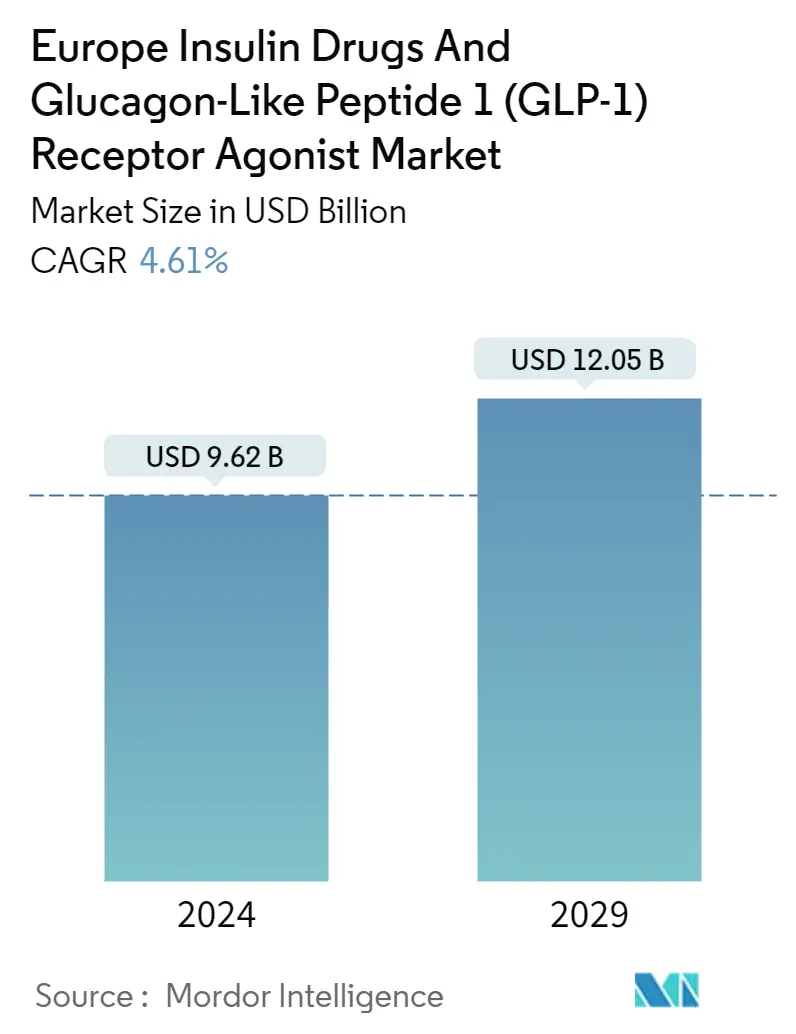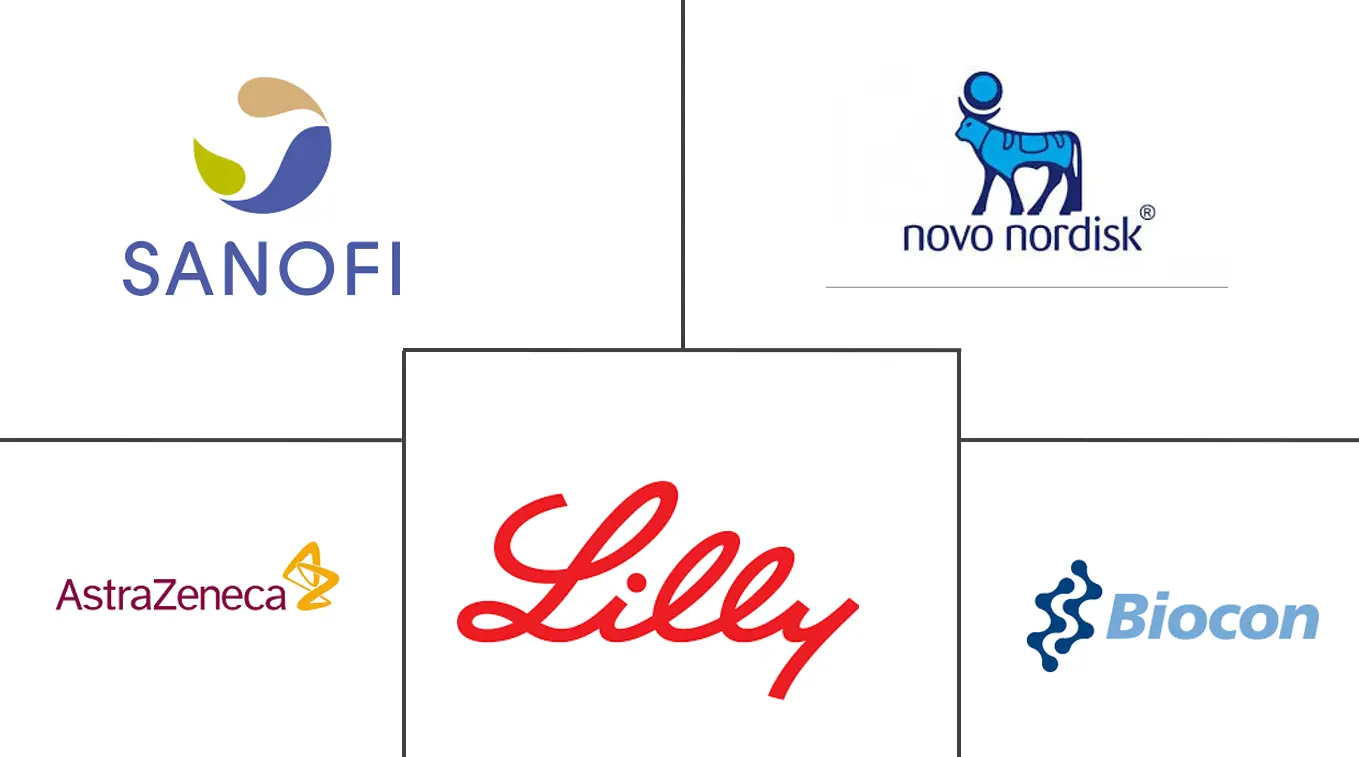Market Size of Europe Insulin Drugs And Glucagon-Like Peptide 1 (GLP-1) Receptor Agonist Industry

| Study Period | 2019 - 2029 |
| Base Year For Estimation | 2023 |
| Forecast Data Period | 2024 - 2029 |
| Market Size (2024) | USD 9.62 Billion |
| Market Size (2029) | USD 12.05 Billion |
| CAGR (2024 - 2029) | 4.61 % |
Major Players
*Disclaimer: Major Players sorted in no particular order |
Europe Insulin Drugs and Glucagon-Like Peptide 1 (GLP-1) Receptor Agonist Market Analysis
The Europe Insulin Drugs And Glucagon-Like Peptide 1 Receptor Agonist Market size is estimated at USD 9.62 billion in 2024, and is expected to reach USD 12.05 billion by 2029, growing at a CAGR of 4.61% during the forecast period (2024-2029).
The COVID-19 epidemic has significantly affected the market for insulin drugs and devices. Patients with type-1 diabetes are more affected by COVID-19. Since people with diabetes already have weakened immune systems, COVID-19 causes those immune systems to deteriorate rapidly. Those with diabetes are more likely to experience significant complications than healthy persons. During COVID-19, the manufacturers of insulin drugs worked with local governments to provide insulin drugs to diabetes patients.
NovoNordisk stated on their website that 'Since the start of COVID-19, our commitment to patients, our employees and the communities where we operate has remained unchanged, we continue to supply our medicines and devices to people living with diabetes and other serious chronic diseases, safeguard the health of our employees, and take actions to support doctors and nurses as they work to defeat COVID-19.' Doctors around the world suggested diabetes patients check their diabetes levels more often to be careful and the intake of medicine has increased, which lead to an increase in the usage of insulin drugs.
The rates of newly diagnosed Type 1 and Type 2 diabetes cases are seen increasing among the youth in Europe. The prevalence of diabetes among all ages in the European region is increasing, mainly due to obesity, unhealthy diet, and physical inactivity. The prevalence of autoimmune Type 1 diabetes is also increasing in Europe, and as per sources, Europe has the highest number of children with Type 1 diabetes. Though Type 2 patients are initiated with oral drugs, insulin may also be required when glucose levels are not well controlled due to an unhealthy lifestyle. Thus, the demand for insulin also exists among Type 2 diabetes patients.
Each drug is unique in the way it works in helping patients with diabetes to keep their condition under control. Certain drugs have similar actions, and they are grouped in the same class. They can also be classified in the way they are administered, with some medicines taken orally and others injected directly into the blood (insulin and GLP-1).
Byetta was the first GLP-1 that received approval in 2005. The glucagon-like peptide receptor agonist is administered subcutaneously and is used by Type 2 diabetes patients to control their blood glucose levels.
The rapidly increasing incidence and prevalence of diabetic patients and healthcare expenditure in Europe are indications of the increasing usage of diabetic drug products. Therefore, owing to the aforementioned factors the studied market is anticipated to witness growth over the analysis period.
Europe Insulin Drugs and Glucagon-Like Peptide 1 (GLP-1) Receptor Agonist Industry Segmentation
A class of drugs called glucagon-like peptide-1 agonists is used to treat type 2 diabetes and obesity. The highlights of this activity will include the medications' indications, mode of action, administration, adverse effect profile, and contraindications. An interprofessional team of nurses, primary care physicians, pharmacists, and endocrinologists is still necessary to provide care for patients prescribed this class of drugs. Europe Insulin Drugs and Glucagon-Like Peptide 1 (GLP-1) Receptor Agonist Market Witness USD 8.2 billion in the current year and is anticipated to register a CAGR of over 3% during the forecast period. Europe Insulin Drugs and Glucagon-Like Peptide 1 (GLP-1) Receptor Agonist Market is segmented into Type (GLP-1 Receptor Agonists and Insulin Drugs) and Geography. The report offers the value (in USD million) and volume (in Units million) for the above segments. We will provide a segment-wise breakdown (Value and Volume) for all the countries covered under the Table of Contents.
| GLP-1 Receptor Agonists | ||||
| ||||
| Liraglutide (Victoza) | ||||
| Lixisenatide (Lyxumia) | ||||
| Dulaglutide (Trulicity) | ||||
| Semaglutide (Ozempic) |
| Insulin Drugs | |||||||
| |||||||
| |||||||
| |||||||
| |||||||
|
| Geography | |
| United Kingdom | |
| Germany | |
| France | |
| Italy | |
| Spain | |
| Russia | |
| Rest of Europe |
Europe Insulin Drugs And Glucagon-Like Peptide 1 (GLP-1) Receptor Agonist Market Size Summary
The Europe Insulin and GLP-1 Drugs Market is poised for significant growth over the forecast period, driven by the increasing prevalence of diabetes across the region. The market is characterized by a rising incidence of both Type 1 and Type 2 diabetes, largely attributed to factors such as obesity, unhealthy diets, and physical inactivity. This surge in diabetes cases has led to a heightened demand for insulin and GLP-1 receptor agonist medications, as these drugs play a crucial role in managing blood glucose levels. The market landscape is dominated by major pharmaceutical companies like Sanofi, Novo Nordisk, and Eli Lilly, which collectively hold a substantial share of the market. Despite the challenges posed by high drug prices and intense competition, these companies continue to innovate and expand their product offerings to meet the growing needs of diabetic patients in Europe.
The impact of the COVID-19 pandemic has further underscored the importance of insulin and GLP-1 drugs, as individuals with diabetes faced increased health risks during the crisis. Manufacturers collaborated with governments to ensure the continuous supply of these essential medications, highlighting their commitment to patient care. Germany stands out as a key market within Europe, driven by its large diabetic population and supportive healthcare policies. The German government regulates drug prices and mandates coverage for all medically necessary treatments, including insulin, which has helped maintain accessibility for patients. As the market evolves, ongoing research and development efforts are crucial to addressing the challenges posed by the rising diabetes prevalence and ensuring the availability of affordable and effective treatment options.
Europe Insulin Drugs And Glucagon-Like Peptide 1 (GLP-1) Receptor Agonist Market Size - Table of Contents
-
1. MARKET INSIGHTS
-
1.1 Market Overview
-
1.2 Market Drivers
-
1.3 Market Restraints
-
1.4 Industry Attractiveness - Porter's Five Forces Analysis
-
1.4.1 Bargaining Power of Suppliers
-
1.4.2 Bargaining Power of Consumers
-
1.4.3 Threat of New Entrants
-
1.4.4 Threat of Substitute Products and Services
-
1.4.5 Intensity of Competitive Rivalry
-
-
-
2. Market Segmentation
-
2.1 GLP-1 Receptor Agonists
-
2.1.1 Exenatide
-
2.1.1.1 Byetta
-
2.1.1.2 Bydureon
-
-
2.1.2 Liraglutide (Victoza)
-
2.1.3 Lixisenatide (Lyxumia)
-
2.1.4 Dulaglutide (Trulicity)
-
2.1.5 Semaglutide (Ozempic)
-
-
2.2 Insulin Drugs
-
2.2.1 Basal or Long-acting Insulins
-
2.2.1.1 Lantus (Insulin glargine)
-
2.2.1.2 Levemir (Insulin detemir)
-
2.2.1.3 Toujeo (Insulin glargine)
-
2.2.1.4 Tresiba (Insulin degludec)
-
2.2.1.5 Basaglar (Insulin glargine)
-
-
2.2.2 Bolus or Fast-acting Insulins
-
2.2.2.1 NovoRapid/Novolog (Insulin aspart)
-
2.2.2.2 Humalog (Insulin lispro)
-
2.2.2.3 Apidra (Insulin glulisine)
-
2.2.2.4 FIASP (Insulin aspart)
-
2.2.2.5 Admelog (Insulin lispro)
-
-
2.2.3 Traditional Human Insulins
-
2.2.3.1 Novolin/Actrapid/Insulatard
-
2.2.3.2 Humulin
-
2.2.3.3 Insuman
-
-
2.2.4 Combination Insulins
-
2.2.4.1 NovoMix (Biphasic Insulin aspart)
-
2.2.4.2 Ryzodeg (Insulin degludec/Insulin aspart)
-
2.2.4.3 Xultophy (Insulin degludec/Liraglutide)
-
2.2.4.4 Soliqua/Suliqua (Insulin glargine/ Lixisenatide)
-
-
2.2.5 Biosimilar Insulins
-
2.2.5.1 Insulin Glargine Biosimilars
-
2.2.5.2 Human Insulin Biosimilars
-
-
-
2.3 Geography
-
2.3.1 United Kingdom
-
2.3.2 Germany
-
2.3.3 France
-
2.3.4 Italy
-
2.3.5 Spain
-
2.3.6 Russia
-
2.3.7 Rest of Europe
-
-
Europe Insulin Drugs And Glucagon-Like Peptide 1 (GLP-1) Receptor Agonist Market Size FAQs
How big is the Europe Insulin Drugs And Glucagon-Like Peptide 1 (GLP-1) Receptor Agonist Market?
The Europe Insulin Drugs And Glucagon-Like Peptide 1 (GLP-1) Receptor Agonist Market size is expected to reach USD 9.62 billion in 2024 and grow at a CAGR of 4.61% to reach USD 12.05 billion by 2029.
What is the current Europe Insulin Drugs And Glucagon-Like Peptide 1 (GLP-1) Receptor Agonist Market size?
In 2024, the Europe Insulin Drugs And Glucagon-Like Peptide 1 (GLP-1) Receptor Agonist Market size is expected to reach USD 9.62 billion.

